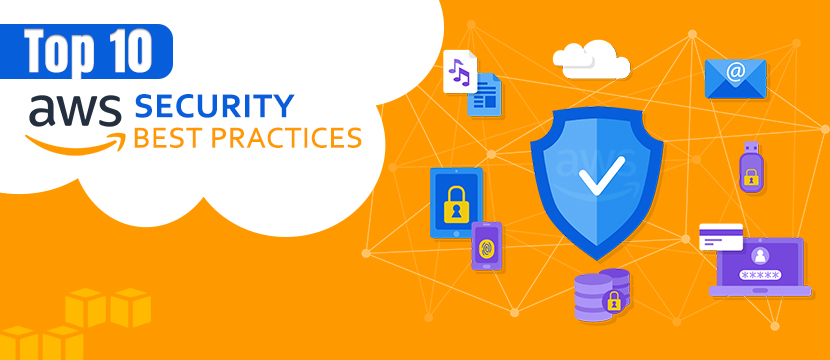The rise of demand for cloud-native visibility of behavior and activity in different AWS environments is evident in present times. However, enterprises are still struggling to perceive AWS security best practices to deal with AWS security issues. AWS has constantly stayed at the top among cloud service vendors all over the world.
The large-scale adoption of AWS presents better prospects for enterprises to consider for jumping on the AWS bandwagon. On the other hand, the widespread lack of knowledge about the best AWS security best practices is a glaring anomaly.
New on the AWS platform? Follow these simple steps and get started with AWS just like a pro.
In 2014, Code Spaces had to encounter an attack on their AWS account that was for deploying commercial code hosting service. Within no time, the attacker had access to the control panel of AWS and demanded money from Code Spaces. Upon the refusal of Code Spaces to pay the money, the attacker systematically deleted various AWS resources of Code Spaces.
The resources included S3 buckets, EBS instances, and all EBS snapshots. The attacker also erased the backups of Code Spaces’ resources which were managed from the control panel. So, the lack of attention to the latest AWS security best practices automatically led to shutting down Code Spaces.
Reasons to Go for AWS Security
Before we move ahead with an outline of ten AWS security best practices, let us note the AWS Security benefits. The four prominent advantages of AWS security can provide better clarification regarding the need for AWS security. The first notable benefit comes in the form of the safety of your data on AWS. The second benefit refers to addressing compliance requisites.
The third benefit is evident in the faster scalability of AWS security according to the demands of your AWS infrastructure. The fourth and most important benefit of AWS security to a business is the cost savings. Prevention of unwanted security incidents can help in warding off any possibilities of system downtime. Also, you don’t have to invest in repairs and recovery from security incidents with AWS security.
Now that you know the reasons to choose AWS security, let us start discussing the best practices for AWS security.
Top 10 AWS Security Best Practices
The cloud is undoubtedly a promising avenue for enterprises to transform their operations into the digital front. However, a closer look at all the possible vulnerabilities and remedial measures can help in safeguarding crucial business data.
The following discussion would present the ten most popular AWS security best practices 2019 that can help your AWS infrastructure. You should pay close attention to each best practice for identifying their importance in ensuring the security of your AWS infrastructure. So, let’s get started.
The foremost entry among best AWS security best practices refers to awareness regarding AWS shared responsibility model for security. The shared responsibility model involves Amazon taking responsibility for its infrastructure security. Platform security is the foremost priority on AWS and is ideal for safeguarding critical customer and application data.
Amazon takes up the responsibility of detecting malicious activity and responding by notifications to the customers. Customers share the responsibility of AWS security by ensuring the secure configuration of the AWS environment and data sharing precedents. Also, customers should note instances of AWS misuse and enforce policies for governance and compliance.
An AWS security best practices checklist includes the focus on shared responsibility, thereby communicating the customer’s share of responsibilities. Amazon takes care of security for managed services while customers have to look after the security of unmanaged AWS services.
2. Multi-factor Authentication
Multi-factor authentication is one of the prominent entries among the most popular AWS security best practices 2019. The massive amount of business-sensitive information on the cloud could not be left to the mercy of standard usernames and passwords. Many security incidents in recent times have shown that hackers can easily compromise login credentials. Therefore, multi-factor authentication serves as an additional barrier for access to your sensitive data.
With the help of multi-factor authentication, users have to follow an additional step for completing the authentication process. AWS security best practices of multi-factor authentication generally involve one-time passwords on the phones of users. Therefore, mere login credentials could not help hackers to compromise your AWS accounts anymore.
Planning to migrate your cloud infrastructure to AWS? Check out these simple steps for AWS migration.
3. Identity and Access Management
The next entry in an AWS security best practices checklist refers to identity and access management (IAM). Users always want to access websites and applications with speed and the assurance of the best security for their data. Identity and access management can provide a combination of three important elements, such as identification, authentication, and authorization.
IAM helps in providing user provisioning and access control privileges for AWS users. Identity and access management is still one of the most common AWS security best practices on AWS. AWS administrators can create and manage AWS users and groups through IAM alongside applying granular permission rules for different users and groups. As a result, unauthorized access to AWS APIs and resources is put under control.
4. Securing Database and Data Storage Services
AWS security best practices for using the AWS database and data storage services also matter a lot. The recent AWS data leaks due to inappropriate configuration of S3 buckets have drawn attention towards securing AWS data storage services. The top AWS security best practices for database and data storage security can take your AWS security to the next level.
Some of the best practices in this context include encryption of Amazon RDS and the data stored in EBS. Other best practices include restrictions on access to RDS instances and enabling RedShift audit logging.
5. File Integrity Monitoring
One of the notable and most common AWS security best practices on AWS refers to the monitoring of file integrity. The best practice in this context refers to the creation of a specific baseline for file integrity and regular monitoring. As a result, you can receive timely alerts about any malicious changes in the files.
File integrity monitoring is one of the most functional AWS security best practices as it relates directly to activities in the cloud environment. You can know about instances when files are modified or opened on AWS infrastructure. Also, you can receive alerts when files are added or deleted in a directory.
6. Improve CloudTrail Functionalities
CloudTrail security configurations are an important part of AWS security best practices. The CloudTrail service on AWS helps in generating log files for all API calls in AWS. CloudTrail is highly crucial for continuous monitoring of AWS activities for post-incident forensic investigations and compliance audits. The best practices with CloudTrail include enabling it for all geographic regions and AWS services and enabling access logging for CloudTrail S3 bucket.
Planning to hire an AWS Consulting Company to handle the security of your infrastructure? Check out the points to consider while choosing an AWS consulting company.
7. SSL Certificates
SSL certificates or Secure Sockets Layer certificates provide encrypted communications between browser and web server. Therefore, it is inevitable to include SSL certificates as formidable elements in the latest AWS security best practices. SSL certificates are vital in protecting sensitive data such as credit card information from theft or compromise.
Certificate Authorities responsible for verifying the identity and credibility of entities requesting the SSL certificate assure trust. Websites without an SSL certificate or with an expired should be immediately reported as a best practice for AWS security.
8. Providing Secure Access to Production
Organizations dealing with continuous delivery should also follow the top AWS security best practices of safe access to production. Security and monitoring for activity in all production servers are highly crucial in this best practice. Security for access to production is possible in different ways. Activity monitoring should focus on suspicious events, such as updates and package installations.
As a result, you can find configuration management as the sole entity for managing your hosts. Most important of all, you should also focus on tracking and monitoring code that is responsible for system configuration. This can help in detecting instances when users manually install packages on hosts, thereby preventing unprecedented security risks.
The most notable best practice to support this entry is the improvement of configuration management. Configuration management helps in executing random code on AWS infrastructure. Therefore, it is essential to make the configuration management very strict for preventing unauthorized access to sensitive data. Some of the measures you can try here include file integrity monitoring or encryption of sensitive data with public keys.
9. Security Strategy
The final yet most undermined best practice for AWS security is an AWS security strategy. Whenever the concerns of AWS security arise, the attention shifts automatically towards tools and processes. However, a strategy for AWS security goes a long way in preparing an organization perfectly for AWS security.
One of the notable elements of an AWS security strategy refers to the education and training of employees. What for? The objective here should be the introduction of a cultural shift from issue solving to issue detection approach.
10. Audit History
Every organization should focus on monitoring user activities that can help in finding out account compromises, risks, and insider threats. Cloud networks provide the essential flexibility for accessing and making changes in the environment according to requirements. However, this creates pitfalls for the comprehensive security of AWS infrastructure. Therefore, the best practice, in this case, is to track user activities.
As a result, you can also ensure the accountability of team members for their actions in the AWS environment. The best outcome of this practice is the prevention of system downtime and compromises that can lead to prominent losses. The selection of appropriate tools for monitoring users effectively can also support in recording and maintaining audit history.
You can also outsource the task of AWS infrastructure management to deal with AWS security issues. Check out the benefits of outsourcing AWS Cloud Infrastructure Management.
Bottom Line
On a concluding note, AWS security best practices in this list are formidable interventions. However, the effectiveness of these best practices is evident only with the involvement of users. The effort of users to learn about best practices for AWS security is very crucial for strengthening AWS security.
Considering the evolution of threats for AWS security in recent times, best practices are benchmarks for a well-functioning AWS infrastructure. Also, you can introspect into the recent security incidents on AWS for finding out common vulnerabilities.
The support of AWS whitepapers and documentation on security best practices can also be an ideal choice for you. So, secure your AWS infrastructure right now with the above-mentioned best practices!










